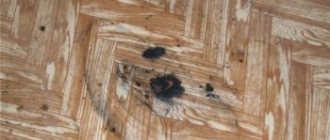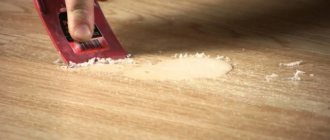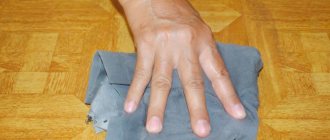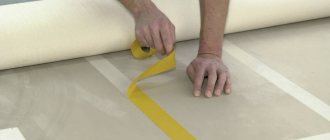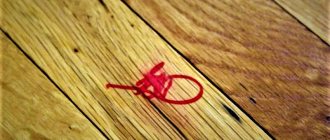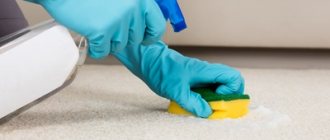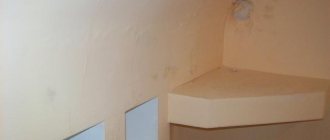The durability of linoleum directly depends on proper and regular care. PVC coatings require periodic (daily) cleaning, application of protective coatings and, as necessary, general cleaning using cleaning equipment. All these activities are carried out using specialized products: cleaners, strippers, polishes (varnishes, mastics, polymer emulsions). Some of them are used to clean coatings, others are used to create a durable protective film on the surface.
- 2 Means for deep cleaning (washing) - strippers
- 3 Protective agents - polishes (mastics, varnishes, polymers, emulsions)
Selecting a detergent
Important! The simplest and most affordable detergent for linoleum is water with soap or dishwashing detergent, floor detergent, or just liquid soap.
The simplest and most affordable detergent for linoleum is liquid soap.
But it is not always possible to achieve the desired result with the help of water.
If you just want to quickly wipe the floor and refresh its color, then plain water will be enough without adding any powders, gels, etc.
If you just want to quickly wipe the floor and refresh its color, then plain water will be enough
But if the dirt is deeply ingrained into the surface, then washing the floor with water so that the linoleum shines will be very difficult, if not completely impossible.
In such a situation, only specially created means for combating complex pollution will be effective.
You can find a huge selection of floor cleaning products on store shelves. Ideally, you need to choose one that is designed specifically for cleaning linoleum. This product does not contain solid particles that can damage the surface. If you wash linoleum with a detergent not intended for this coating, then there is a high risk of damage, and it will no longer be possible to return the previous appearance.
Detergents differ according to the method of application:
- for regular cleaning;
- with dirt-repellent and protective properties;
- universal.
Each type of product has its own unique composition, so you should never mix them. This will not increase efficiency, quite the contrary. You should not choose gels and powders that contain chlorine, alkali or soda.
You can find a huge selection of floor cleaning products on store shelves.
Some housewives solve the problem of how to wash linoleum to make it shine very simply: they wash the linoleum with powder or laundry soap. In fact, such “supplements” do not give the desired result. After the surface dries, the desired shine does not appear; on the contrary, white stripes are visible on the floor, and it has to be washed.
What can't you clean it with?
First, let’s put aside the products that are not suitable for linoleum.
, For example:
- Avoid hot water immediately. It can make him swell.
- Often housewives, sharing their experience, recommend using soda. And put it aside. The alkali contained in this product causes damage to the surface over time. Baking soda is more suitable for dishes with a smooth structure.
- Abrasive products scratch it.
- Solvents and bleaches, which we sometimes use to remove stains, will discolor the design, and in severe cases can leave a corroded stain, all the way to the base.
It turns out that everything is not so simple, I wiped it with a rag and forgot. Any thing requires proper care, linoleum is no exception. After we have put the substances that are harmful in our case into the drawer, let’s think about what can be used.
How to properly wash linoleum?
To make linoleum shine, it is necessary not only to choose products, but also to properly care for the surface.
Before you start wet cleaning, you should remove all small debris from the surface.
Before you start wet cleaning, you should remove all small debris from the surface using a vacuum cleaner, brush or regular broom. In the first 3-4 weeks after flooring, this cleaning method remains the main one, since washing linoleum is not recommended. It needs to “rest” for a bit, and excess moisture can cause waves.
It is equally important to wash linoleum to make it shine. Wet cleaning can be done manually or using a mop, but in any case you need to choose the right material for the rag. The floor covering will retain its appearance for a long time if washed with a soft cloth or a soft bristle brush.
Important! This material does not tolerate high temperatures well, as do abrasives.
Therefore, after washing the floor, you need to immediately wipe it dry with a piece of flannel. This method is suitable if you plan to remove dust regularly. This will help simplify tidying - all you need to do is wipe the floor with a damp cloth.
More complex contaminants can be effectively removed using gasoline
If there are stains on the surface, dry cleaning is also carried out first. Then a cleaning solution (gel, soap, etc.) is applied to the stain. The contaminated area is carefully treated.
Regular dishwashing detergent works well for greasy stains. More complex stains (traces of dyes, coffee, iodine, shoe polish, etc.) are effectively removed using gasoline or kerosene. If the area of contamination is small, then you can get by with an ammonia solution or nail polish remover. Tile detergent helps against limescale stains. Lemon juice helps remove mold or rust.
Important! To keep linoleum shiny, it is important not to leave stain removal until later, but to try to remove it immediately. Otherwise, contamination can become deeply embedded in the material and ruin its appearance.
Lemon juice helps remove mold or rust from linoleum
Another common problem is color loss. The protective layer of linoleum is made up of wax and a polymer base. It has sufficient strength, but under the influence of certain factors it can be damaged. Discoloration of the coating occurs due to direct sunlight and exposure to chemicals.
Scratches can be “camouflaged” with wax
It’s easy to protect linoleum from sunlight - just close the curtains. And to remove dirt from the floor, you should not use products with a bleaching effect. They will only lead to the coating losing its shine, and it will be impossible to restore the appearance.
Another common coating problem is small scratches that occur due to small pebbles that can be “carried” on the soles of shoes. Scratches cannot be removed, but they can be “camouflaged”: you need to wipe the damaged area with wax.
Replacing a section - making a patch
Linoleum is usually not laid near fireplaces and stoves, as flying sparks can burn the surface. For the same reason, it is necessary to carefully handle burning matches, which can melt a thin film of PVC coating. This is especially true for people who smoke. Unfortunately, it will not be possible to get rid of such a burnt stain. This section will have to be replaced with a new piece of linoleum.
To ensure a perfect match of the pattern and even edges, you need to:
- place a new piece of linoleum on top;
- use a special knife to cut through two sheets at once;
- remove the flap with the defect;
- Clean the floor surface from glue residues;
- dry the base;
- apply glue and stick the cut out new piece;
- If necessary, seal the seams with cold welding.
Cleaning products for linoleum
You can find many different cleaning and shine products on store shelves. Therefore, you need to know how to wash linoleum to make it shine.
MELLERUD is a good choice for frequent cleaning.
MELLERUD is a good choice for frequent cleaning. It allows you to create a protective layer on the surface and return the material to its former shine. It contains active substances from natural ingredients. For cleaning, it is important to dilute the product in lukewarm water. Before cleaning, sweep the floor and then apply the prepared solution in the usual way.
Wa-Lin is a universal product for regular cleaning by hand or with floor washing equipment. Wa-Lin can be used to clean all types of linoleum, but it is a good idea to test the reaction of the coating on a sample or in an area where possible damage will not be noticeable before application. You only need to dilute the product before washing the floor. It is important to protect your hands from exposure to alkali. For this purpose, special rubber gloves that are resistant to chemical attack are suitable.
Since some detergents are quite aggressive, the question arises of how to wash linoleum so that it shines, but at the same time not damage the skin on your hands during cleaning. In such cases, San Klin is recommended. It is suitable for cleaning linoleum, as well as other materials (wood, tiles). The prepared solution is applied to the surface and left for a few minutes (for light contamination). Then it should be washed off with clean water.
The HG product, designed for cleaning linoleum and vinyl flooring, can effectively clean the floor from dirt and make it shine. To remove dirt, simply wipe the floor with a solution. There is no need to rinse it off or dry it. When the floor begins to dry, you can polish it a little to add shine.
Rules for caring for PVC coatings
Regular maintenance will prevent the floor from becoming heavily soiled, so you won’t have to worry about how to clean the linoleum. PVC coatings contain polyvinyl chloride, so solvents and acetone should not be used when cleaning the floor. Since these substances easily react chemically with polymers, which include polyvinyl chloride.
For high-quality care and reliable protection of floors made of PVC coatings, a polymer layer should also be periodically applied. This will protect the coating from mechanical stress and from ultraviolet radiation, which affects the brightness of the color of the coating.
The protective layer should be applied to a dry, clean floor in two steps. After treatment, do not walk in the room for ten hours. Most of all, heterogeneous PVC coatings, in which the top layer is very thin, need protection.
How to restore shine to linoleum?
The appearance is lost not only from the influence of various harmful factors, such as aggressive chemical exposure, sunlight, etc. In many ways, how soon linoleum begins to lose its shine is influenced by its quality. If linoleum is cheap or of poor quality, then it is unlikely to please with its beautiful appearance for a very long time. Higher quality material, on the contrary, retains its original appearance and shine longer.
Potato broth will help restore shine to linoleum
But in any case, sooner or later the question arises of what to rub the linoleum with to make it shine. Folk remedies will come to the rescue with this. They include components that can be found in any apartment.
Regular potatoes will help restore the shine to linoleum. More precisely, not the tubers themselves, but a decoction of them. When it is ready, it needs to be added to the water intended for washing the floor and mixed well. Before doing this, the floor must be swept or vacuumed well. Then you can apply the decoction.
If you don’t have potatoes in the house or don’t want to use them, you can use potato starch, which is no less effective. Then 2-3 tablespoons of starch are added to the water and applied to the surface in the same way.
Cow's milk gives linoleum shine
An equally popular and accessible folk remedy is cow's milk. This method is widely known and has been used for several generations. This is what is often recommended on websites and forums when people ask what to do to make linoleum shine.
Milk needs to be diluted in the same amount of water, mixed and washed. Immediately after this, the floor must be wiped without waiting for it to dry. This method does not always give the desired result from the first use. You should be prepared for the fact that the procedure will have to be repeated several times to make the linoleum shine.
Regular vegetable oil helps restore shine to linoleum. The floor must first be swept and thoroughly rinsed with water and oil. After this, polish the surface with a woolen cloth or dish sponge. This treatment immediately produces results. The disadvantage is that it is not suitable for all types of linoleum. Thus, such treatment is not suitable for cheap linoleum, since oil can only damage the coating.
Cleaning after repair
The question is often asked: how to clean linoleum after renovation without streaks.
The simplest thing is to prevent contamination altogether, of course: before starting work, always cover the floor with plastic film, preferably in several layers. Or get the invited team to do this. But if this preparation was not done, or at some point the film moved away, the problem can still be solved.
Even a very dirty floor can be cleaned like this:
- use a spatula to remove all large remnants of finishing materials and sweep away dust and small particles;
- to finally deal with dust and white deposits, wash the floor in several waters, each time with a new rag;
- remove stains with a solution of potassium permanganate or table vinegar;
- Treat very difficult and stubborn stains with white spirit (strictly according to the instructions, working with rubber gloves).
Traces of varnish and paint need to be cleaned as soon as possible. Water-based compounds (fresh) are removed with wet wipes or unnecessary damp rags. Oil paints are blotted with dry cloths and removed with sunflower oil, and what remains after this treatment is removed with soapy water or cleaning agents.
The polyurethane foam is carefully cut off with a knife, and the frozen crust is soaked and then carefully scraped off the surface
Linoleum polishing products
Polishing varnish will create a new protective layer and add shine.
It is worth knowing when choosing what to wash linoleum with to make it shine, folk remedies are effective, but the result of their use is usually temporary. The shine after treatment with potato broth or milk quickly disappears, which makes it necessary to polish the floor again.
Modern products can help in adding shine, of which there are now many from a variety of manufacturers. They will be more effective on the old coating, since instead of an erased protective layer, they essentially create a new one, due to which the desired appearance and shine is achieved.
Previously, special floor mastic was used for the same purpose. It can be used now, but this is not the best option: over time, the top layer created using such mastic begins to crack and become cloudy. When treating with mastic, it is important not to overdo it, since some types of this product for making linoleum shine make the floor too smooth and slippery, which is simply dangerous.
Varnishes help maintain the strength and elasticity of the coating for a long time
More modern means are varnishes and polishing waxes, which create a new protective layer. If mastic was previously used to restore shine, this layer must be removed. Only then can you proceed to processing.
First of all, the floor needs to be washed with warm water with the addition of a regular detergent; even one intended for washing dishes will do. Then you need to wipe the floor surface with a dry cloth. Apply the varnish evenly to the surface and rub in with a dry cloth. Repeat the procedure after the floor has completely dried, that is, after about 10 hours.
Modern varnishes for adding shine to linoleum contain polymer-based additives, which help maintain the strength and elasticity of the coating for a long time.
In addition to application, you need to know how to care for linoleum so that it shines, maintaining its normal appearance for as long as possible. It is not necessary to reapply varnish to restore the protective layer so often - about once every six months or a little more often, depending on the intensity of use of the room. In addition, every week you need to renew the coating using a special polish. To facilitate the procedure, polish can be added to water for wet cleaning.
Conclusion
We figured out how to restore the shine of linoleum and protect it from wear and contamination, because polish not only improves the appearance, but also creates a reliable wear-resistant layer. The video in this article will help you understand the issue even better, but if something remains unclear to you, then write your questions in the comments below.
Did you like the article? Subscribe to our Yandex.Zen channel
June 1, 2016
Linoleum, Floor cleaning
If you want to express gratitude, add a clarification or objection, or ask the author something, add a comment or say thank you!
Types of ready-made compounds
Many types of linoleum mastics sold in stores are universal. Only linoleum without a base requires a special composition. However, before purchasing, you need to carefully read the composition and manufacturer’s recommendations. These are mainly rubber-based mastics and are suitable for:
- Relina.
- PVC linoleum.
- Nitrocellulose linoleum.
- Natural linoleum.
Repairing slits and unraveling seams
If a hole in the coating was formed as a result of a cut, that is, it has smooth edges, it will not be difficult to eliminate it without a trace. The same applies to the separated seams between the canvases.
The seam of the canvas has come apart
To work, you need double-sided tape, a roller and a primer.
Step 1. The edges of the canvas are slightly turned to the sides and dust and accumulated debris are cleaned out.
Step 2. The rough base is primed and dried.
Step 3: Place double-sided tape into the gap and attach it to the base along the seam.
Gluing double-sided tape
Step 4. Remove the protective coating and press the edges of the linoleum, then iron it with a roller.
If the edges of the linoleum do not meet tightly and a gap of 1-2 mm remains, you need to additionally process the seam using A-type cold welding. After this, it is almost impossible to detect the slot, and the coating will last for many more years.
We paint it ourselves
The painting process has always been considered one of the simplest technological activities. Painting linoleum is difficult and time-consuming, so you must at least be patient. After applying the paint, all defects and problem areas of the linoleum will be clearly visible, so approximately 2/3 of the working time will have to be spent on repairing and cleaning the floor covering.
A relatively new floor can be varnished
Preparation of linoleum
It is clear that before applying paint, the surface must be repaired. All holes and cuts are sealed with epoxy compounds, putties and primers, rubbed and polished to a shine. Sometimes the finishing procedure has to be repeated in order to finally get rid of the protruding repair layer.
If linoleum has been periodically treated with grease or wax mastics, then the material must be washed using liquid soap. Open joints between the panels are cleaned of dirt with a brush or brush with solvent P650.
Important! Regardless of what paint you plan to use to repair linoleum, first of all you need to get rid of grease stains. Usually their presence on linoleum is determined by reflection in a reflected stream of light, after which the place is cleaned with an acetone-alcohol mixture or hot water with caustic soda
Before starting painting work, you need to collect dust from the walls with a clean rag, close the ventilation and windows and seal the baseboards with tape.
Usually their presence on linoleum is determined by reflection in a reflected stream of light, after which the place is cleaned with an acetone-alcohol mixture or hot water with caustic soda. Before starting painting work, you need to collect dust from the walls with a clean rag, close the ventilation and windows and seal the baseboards with tape.
Features of the linoleum painting process
Paint the floor covering with a paint roller in two passes. If the floor has been previously primed, then it is enough to apply one coat in a herringbone pattern. For oil-based paints and varnishes, the surface is wiped with a thin layer of drying oil and left until completely dry. In other cases, they save on the primer and simply apply two layers of paint.
Multiple colors can be used
The first time is painted in parallel stripes, overlapping by half the width of the roller. The applied layer of paint should not be too thick; it is enough if the pattern on the linoleum is visible. The second layer is laid in such a way that the gloss of the paint appears, and at the same time the texture of the old base does not appear.
The paint layer is dried for a very long time, 2-3 days; after drying, the coating is washed with soapy water and left in this state for another 24 hours.
If linoleum was laid on a concrete floor, the drying time may increase by 20-30%.
Mastic for linoleum - features and methods of self-preparation - Floor School
At the moment, the range of adhesives for linoleum flooring is quite large. The most durable fastening of linoleum is considered to be installation using mastic. Next, we will look at the different types of such adhesives, their features, as well as recipes for making them yourself.
Applying mastic to the base for gluing linoleum
What mastics are used when laying linoleum
To glue felt and fabric-based linoleum to wooden floors, you can use the following types of mastic:
- "PS-B";
- "DFK";
- "Syntalax";
- "Gumilax";
- "Geryslax";
- "Biskey";
- "Acrylax".
For coating without a base, compositions based on rubbers and synthetic resins are used. Next we will look at the most popular mastics.
Bisky
Biski mastic for gluing linoleum, which is a black viscous mass, has become widely popular. It can be used when laying polyvinyl chloride and glyphthalic linoleum on a fabric basis.
“Biskey” is not difficult to buy at almost any hardware store.
Its advantages include the following properties:
- Non-flammable;
- Absolutely harmless;
- Provides reliable adhesion of linoleum;
- Not difficult to make at home.
Cooking method
To prepare Bisque you will need the following ingredients:
- 65% bitumen BN-IV;
- 4% turpentine;
- 22% white spirit;
- 7% Portland cement;
- 2% rubber cement.
The manufacturing instructions are as follows:
- Large dishes must be filled two-thirds with bitumen, heated over a fire and brought to a temperature of 150 degrees, i.e. until completely melted.
- Then you need to remove all impurities and slightly cool the bitumen.
- After this, the contents of the container are thoroughly stirred and cement is added.
- Next, the contents should be cooled to a temperature of 70-80 degrees Celsius and turpentine and white spirit should be poured in a thin stream. In this case, the mixture must be constantly stirred.
- Lastly, you need to add rubber glue.
"Biskey"
Storage
The Biski adhesive mixture can be stored for quite a long time, but no more than three months, provided that tightly closed containers are used. Three months after preparation, it thickens, after which it can no longer be used.
Note! Approximately one kilogram of mastic is consumed per square meter of floor.
Flour mastic with turpentine
This type of composition can be used for laying alkyd linoleum on well-dried and puttied wooden bases. Moreover, a dried base is a prerequisite, since otherwise the paste will quickly rot, causing the linoleum to peel off.
Its advantages include:
- Reliable adhesion in the absence of moisture;
- Environmental friendliness;
- Ease of manufacture;
Preparation method
To prepare this mastic you will need the following ingredients:
- 18 parts drying oil;
- 18 parts of OB brand casein glue;
- 36 parts water;
- 36 parts limestone flour.
Applying mastic to the base using a roller
Mastic is made as follows:
- First of all, you need to soak the glue in warm water in a small amount of water, let it swell, then stir well until a homogeneous mass is formed.
- Pour the remaining water into the dissolved glue and leave the mixture for 30 minutes so that the glue completely swells.
- Then pour drying oil into the resulting mixture in a thin stream. Then the contents of the dish must be mixed until a homogeneous emulsion is obtained.
- Next, add limestone flour in small portions.
Storage and use
This mastic cannot be stored for a long time, so it must be used up within 4-5 hours. If you need to perform a large amount of work, it is better to produce it in small portions.
The consumption of casein-emulsion mastic is one and a half to two kilograms per square meter of base.
Mastic for protecting the surface of linoleum
In the photo - applying protective mastic to linoleum
It performs the following functions:
- Anti-slip.
- Makes the surface of linoleum smooth and matte (or vice versa glossy)
- Prevents dirt from penetrating into pores and thus simplifies maintenance.
- The protective film increases the abrasion resistance of the coating.
Thus, the use of a protective film will increase the performance properties of linoleum. Its only drawback is the rather high price, however, given the cost of the material itself and the increase in its service life, it makes sense to spend money once. Since this mixture has a complex composition, you cannot prepare it yourself.
Hot welding
You can glue linoleum joints using hot welding. This is a very reliable method that allows you to create a sealed seam that practically does not stand out from the background of the surface, but it is not suitable for all types of flooring material. Hot welding can only be used for high-strength coatings; ordinary household linoleum will simply melt.
To work, you will need a hot air gun, nozzles for it, as well as several special knives. One is for creating a groove along the entire length of the seam, the second is for cutting off excess molten welding cord. The tool is quite expensive, but since it will not be used often, it can be rented.
Gluing procedure:
- A special polymer cord (welding rod) is inserted into the hot air gun, which will fill the seam as the material melts.
- The edges of the linoleum are firmly joined, a small V-shaped groove is cut along the entire joint, a few millimeters smaller than the cross-section of the cord.
- The resulting gap must be cleared of debris and the edges of the linoleum must be degreased with an alcohol-containing solution.
- The hot air gun is heated to the temperature specified in the instructions (usually it ranges from 300 to 500 C°).
- The tip is placed at the beginning of the groove and slowly moves along it.
- The seam is completely filled with liquid polymer, which should protrude slightly above the edges. If the cord does not melt well, the temperature increases.
- After welding, the polymer is left in the seam until it hardens completely. Then the protruding excess is removed. While the cord is still liquid, this cannot be done, since the material shrinks. If you hurry, the seam will end up with a depression. Excess polymer is removed from the joints while the product is still warm.
Cold welding is a method of gluing surfaces with special compounds. The technology eliminates processing with hot air. This is the optimal method for joining the edges of linoleum in an apartment. The compositions that are used for this (“A”, “C” and “T”) are selected in accordance with the type of material being joined and the size of the gap.
- If you need to glue a new coating immediately after installation, then type “A” glue is used. It has a liquid consistency, making it ideal for tight joints and goes well with soft coatings. It is inserted with a needle that comes with the tube. The seam is almost invisible.
- If the linoleum was laid a long time ago, then the edges are connected with type “C” glue. It has a thicker consistency than type “A” composition. The glue, filling the voids, reliably holds the seams together, preventing them from coming apart in the future.
- Type “T” glue is used to glue insulated PVC coverings on a felt or polyester base. It is toxic and difficult to use, used by professionals.
The gluing method using cold welding is very simple:
- The seam line is sealed with masking tape.
- Using a sharp knife, cut the tape exactly along the joint.
- Using a nozzle, glue is introduced into the gap between the edges of the coating.
- Excess welding is cut off already frozen.
Preparing the foundation
An important process before laying such a covering is thorough preparation of the floor surface. Linoleum can be laid on both wood and concrete.
Features of preparing a wooden base
First of all, you need to carefully examine the base of the floor. If it does not show signs of rotting or mold, but only has minor flaws (cracks, pits, unevenness), then we proceed as follows:
- We stretch (secure) each board, without exception, while the heads of the screws must be “recessed”;
- We remove the bulges with a plane or grinder;
- We putty all the recesses, even the smallest ones;
- We fill large gaps with special slats;
- Finally, we go over the base again with a sander.
It happens that a wooden floor is worn unevenly. In this case, it is better to lay moisture-resistant plywood on it. Laying linoleum on it will simplify your work as much as possible.
If a wooden floor is completely unsuitable for further use, there is no need to tempt fate and be overly economical. The best solution would be to replace it completely.
Features of preparing a concrete base
If you have a flat floor, which is very rare, you don’t need to do any special work. It is enough to thoroughly clean it with your own hands and treat it with a primer.
If the foundation needs reconstruction, it is necessary:
- Find out the size of slopes or protrusions using a laser level or a simple level.
- Seal large cracks with polyurethane foam.
- If the number of defects (slopes, irregularities, potholes, bulges) totals more than 20% of the entire surface, it is best to make an additional screed. A self-leveling cement-based floor mixture is ideal for this.
- After the screed has dried, measure the angle between the wall and the floor; it should not deviate from 90°.
Thus, we should get a perfectly flat floor with reliable sealing. In this case, the coating is given the opportunity to change its size depending on changes in humidity and temperature. Otherwise, the linoleum will collect and wrinkle.
Before laying linoleum, you need to measure the humidity in the room. If it is higher than 85% at +18°C, it is imperative to lay a moisture-proofing layer. Without laying such material, linoleum flooring is not recommended!
Other repair options
When linoleum burns through, the question arises of how to fix it. In fact, you can not only repair, but also decorate the resulting defect. Subsequently, it will become a beautiful decoration of the room. There are several options to solve the problem.
Special stickers
Decorative floor decals can be found at a hardware store. They may have different patterns. You can even choose a model that will match the stylistic design of the room. The kit includes glue and a special tool for proper installation.
Application
Instead of stickers, appliqués are often preferred. This approach is ideal for eliminating defects in a children's room. Such decor can look like a child’s drawing or a cartoon character. Typically, a play area is set up with this design.
Decoupage on linoleum
This idea only applies if the owner prefers a similar style. At the same time, the room must correspond to the interior direction, which is characterized by the use of decoupage techniques.
In case of major damage, it is easier not to put a patch, but to completely re-lay the linoleumSource remontnik.ru
Materials
Linoleum comes in different types. After reading the brief characteristics, it is not difficult to make a choice. Linoleum happens:
- Made from natural materials. This linoleum is made from linseed oil, tree resin and other natural materials. In addition to being environmentally friendly, it is non-flammable, does not absorb fat and is resistant to the growth of microorganisms. These are some pretty serious benefits.
- Made of rubber. Relin (aka rubber linoleum) is moisture resistant and more flexible.
- Made from PVC. The quality and price of such linoleum depend on the substrate and the number of layers. It is warm, but it shrinks a lot and has a specific smell for a very long time. This is not suitable for everyone.
- Alkyd. This type has good sound and heat insulation, but is more fragile than the others. It is not suitable for premises with frequent traffic.
- Made from nitrocellulose. Such a floor will be very beautiful, with a noble shine, but due to the lack of a backing it will be easily flammable.
Flour mastic with turpentine
This type of composition can be used for laying alkyd linoleum on well-dried and puttied wooden bases. Moreover, a dried base is a prerequisite, since otherwise the paste will quickly rot, causing the linoleum to peel off.
Its advantages include:
- Reliable adhesion in the absence of moisture;
- Environmental friendliness;
- Ease of manufacture;
Cooking method
To make this adhesive composition with your own hands you will need the following ingredients:
- 15 parts of turpentine;
- 85 parts peklevanny or rye flour;
- Water.
Installation of linoleum on flour mastic with turpentine
The adhesive composition is prepared as follows:
- Flour must be diluted in water at room temperature to the consistency of batter or sour cream.
- The resulting mixture must be poured into a pan of boiling water, stirring thoroughly.
- The contents of the dish should be simmered for some time over low heat with constant stirring until the flour is cooked.
- You need to pour turpentine into the finished paste, then mix the mixture thoroughly.
- Then 2 grams of carbolic acid must be added to the resulting mastic to give the mastic antiseptic properties.
